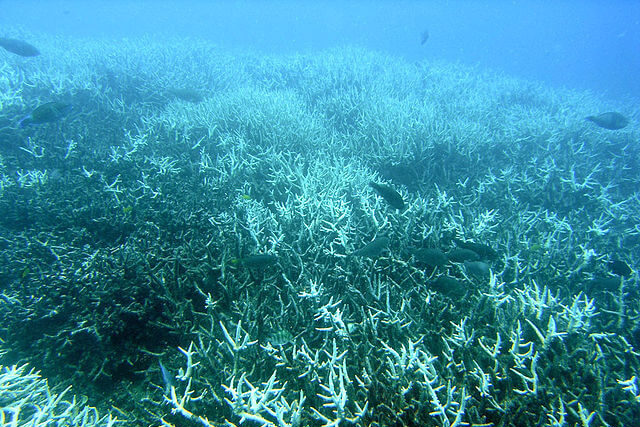
Climate change has significantly impacted the world’s oceans, leading to record-breaking temperatures every day over the past year, according to analysis.
Nearly 50 days within this period have seen unprecedented highs for the time of year by the largest margins recorded since the satellite era began.
The primary drivers behind this alarming trend are greenhouse gases, with the natural El Niño phenomenon also contributing to the warming of the seas. These super-heated conditions have severely affected marine life, prompting a new wave of coral bleaching.
The analysis, which utilises data from the EU’s Copernicus Climate Service, also highlights that last month was the warmest April on record for global air temperatures. This continues a streak of month-specific records extending to 11 consecutive months.
Historically, the world’s oceans have acted as a buffer against climate change, absorbing about a quarter of the carbon dioxide produced by human activities and soaking up around 90% of excess heat. However, the past year has shown worrying signs that this capacity is being overwhelmed, especially at the sea surface.
From March 2023, the average surface temperature of the global oceans began to rise sharply above the long-term average, reaching a new record high in August.
This trend persisted, with the sea surface achieving a new global average daily high of 21.09°C in February and March this year, based on Copernicus data.
Since 4 May 2023, every single day has broken the daily temperature record for that time of year. On about 47 of these days, the previous records were exceeded by at least 0.3°C, an unprecedented margin in the satellite era.
The most notable record-breaking days were 23 August 2023, 3 January 2024, and 5 January 2024, when the previous highs were surpassed by approximately 0.34°C.
“The fact that all this heat is going into the ocean, and in fact, it’s warming in some respects even more rapidly than we thought it would, is a cause for great concern,” says Prof Mike Meredith from the British Antarctic Survey.
“These are real signs of the environment moving into areas where we really don’t want it to be and if it carries on in that direction the consequences will be severe.”
This human-induced warming of the oceans is significantly affecting global marine life and may be altering the seasonal cycle of sea temperatures.
One of the most severe consequences has been the widespread bleaching of coral reefs. These essential nurseries for marine life turn white and die when water temperatures become too high. Coral reefs support about a quarter of all marine species, making their decline a critical issue for ocean ecosystems.
The unusually warm seas have also impacted other marine creatures, such as the emperor penguin in Antarctica.
“There have been examples of the sea-ice collapsing before emperor chicks have properly fledged, and there have been mass drowning events,” says Prof Meredith.
“The emperor penguin is a threatened species because of climate change, and the sea-ice and the ocean temperatures are strongly implicated in that.”
In the UK, rising sea temperatures have caused the disappearance of several coastal species, including some barnacle varieties.
“The problem of climate change is that it’s happening too quickly for evolution to catch up with it,” says marine biologist Dr Nova Mieszkowska from the University of Liverpool.
Researchers from Aberystwyth University, using forensic technology to monitor marine populations in Cardigan Bay, have found that invasive species are thriving in these warmer conditions. One example is a sea squirt from Japan that blankets the sea floor like a carpet.
“They prevent the growth of native organisms in the areas that they colonise,” says Prof Iain Barber, head of Life Sciences at Aberystwyth University. “Because they do so well in our environment, they can potentially take over huge areas of the seabed.”
Prof Barber notes that more invasive species seem to respond more vigorously to global warming and rising sea temperatures.
The El Niño weather phenomenon, which brings warmer waters to the surface of the Pacific Ocean, has exacerbated the impacts of human-driven emissions over the past year. El Niño began in June 2023 after a period of cooler La Niña conditions and peaked in December, though it has since started to wane.
Despite El Niño’s influence, other ocean basins not typically affected by this phenomenon have also experienced record marine heatwaves, leaving scientists puzzled about the underlying causes. This persistent heat in many ocean basins, including the tropical Atlantic, can energise tropical storms, potentially leading to a more severe hurricane season.
“The Atlantic has been warmer than usual, and this is not a pattern you normally associate with El Niño – so it’s something somehow different,” explains Carlo Buontempo, director of Copernicus.
“There is still a large patch of warmer than usual water in the tropical Atlantic [and] this is the main development region for tropical cyclones,” explains Dr Buontempo.
“We are almost a month ahead in the sea surface temperature in the Atlantic with respect to the annual cycle […] so this is an area that has to be watched.”
In addition to these immediate impacts, researchers warn of long-term consequences that society must address. Ice-sheet melting and deep-ocean warming will likely continue to contribute to sea-level rise for centuries.
“When we talk about climate change, we tend to reduce that to changes on the surface because we live there,” said Angélique Melet, a researcher with Mercator Ocean International.
“However, the deep ocean is one of the aspects [of global warming] that is committing us to centuries and millennia of [climate] change.”
However, Dr. Melet emphasises that this is not a reason to abandon efforts to reduce emissions.
“Depending on our actions, we can reduce the speed of that warming, and we can decrease the overall amplitude of that warming and sea-level rise.”
——————————————————————————
At Natural World Fund, we are passionate about rewilding the UK to stop the decline in our wildlife.
Donate now and join in the solution!

